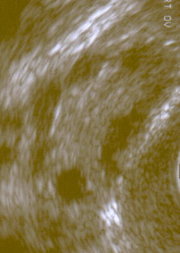INTRODUCTION
Polycystic ovary syndrome (PCOS), a combination of metabolic, endocrine and reproductive irregularities, may be the most common endocrine disorder and cause of infertility seen in women (Marshall, 2001). A true estimate of prevalence is not available, due to differences in diagnostic criteria; however, rates could be as high as 10% in the North American female population (Hoyt et al., 2004).
PRESENTATION
Symptoms of PCOS commonly include amenorrhea or oligomenorrhea, anovulation or irregular ovulation, infertility, presence of ovarian cysts, enlarged ovaries, hyperandrogenism, weight gain, male pattern fat distribution and hair loss, excess facial and body hair, skin tags, and acne (Marshall, 2001). Women with PCOS experience abnormal androgen production, the cause of which is unknown. An outcome of this hormone imbalance is hyperinsulinemia and consequent insulin resistance (Balen, 2004). Thus, women with PCOS are often diagnosed with type II diabetes. Fifty percent of women with PCOS are obese (Marshall, 2001) and many have hypertension and dyslipidemia.
MANAGEMENT
There is no specific treatment for PCOS. Instead, physicians who practice traditional western medicine try to alleviate symptoms through various drugs that target the different attributes of the disease. Drugs include oral contraceptives, insulin-sensitizing agents and anti-androgen drugs (Marshall, 2001). The potential ineffectiveness, costs and side effects of these drugs has spurred research into alternative treatment options, including diet and lifestyle interventions.
Role of diet
Due to the relationship between hyperinsulinemia and hyperandrogenism, improved insulin sensitivity may decrease androgen production, and thereby minimize many of the symptoms associated with PCOS (Hoyt et al., 2004). Diet and lifestyle changes are helpful in managing insulin sensitivity. Nutrition research has focused on the low glycemic index (GI) diet and reducing body mass. Both interventions have been shown to improve insulin sensitivity, thereby improving reproductive hormone imbalances (Hamilton & Fairly, 2000: Clark et al, 1995). Foods with a low GI are slowly digested and produce a prolonged postprandial insulin release (Augustine et al., 2002). Choosing foods that supply glucose to the cells at a steady rate results in moderate insulin demands and may help improve insulin resistance (Bell & Sears, 2003).
Studies have shown that a 5-10% reduction in weight can potentially improve serum androgen levels and fertility in obese women with PCOS (Moran & Norman, 2004), so weight reduction should be highly recommended for these women (Moran & Norman, 2004). Simple carbohydrates and breads made from refined flour products may aggravate insulin resistance and promote weight gain, thereby compounding symptoms associated with PCOS (Scalzo & McKittrick, 2000). Conversely, a low GI diet is associated with weight loss in women with PCOS because it emphasizes high fibre vegetables, legumes and fruit, lean protein, whole grains and heart-healthy fats, leading to increased satiety and less overeating (Scalzo & McKittrick, 2000). A low GI diet could be beneficial in the treatment of PCOS by improving insulin sensitivity and promoting weight loss. The low GI diet is easy to follow, includes foods from all four food groups and therefore may be used as a safe and feasible lifestyle approach to managing PCOS (GilbertsonetaL, 2003).
Nutrient supplements have possible benefits for the treatment of insulin resistance associated with PCOS. These include: omega-3 fatty acids, which are found in fish oil and increase glycogen storage (Clarke, 2000), chromium, a mineral involved in insulin utilization pathways in the body (Schmidt-Finney & GonzalezCampoy, 1997) and d-chiro-inositol, a phosphoglycan involved in insulin uptake (Luorno et al., 2002).
References available from the authors.
Contact Information:
Cheryl Allen, BASc
Dandle Crake, BASc
Heather Wilson, BASc
Andrea Buchholz, PhD, RD
(Faculty Advisor)
University of Guelph
Guelph,ON
abuchhol@uoguelph.ca
(519) 824-4120 (52347)
Copyright Dietitians of Canada Summer 2005
Provided by ProQuest Information and Learning Company. All rights Reserved



